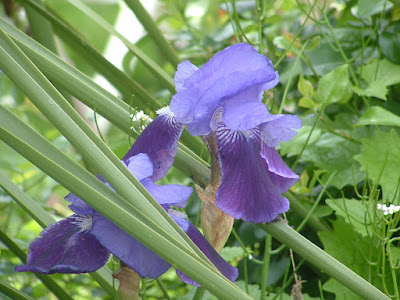I'm taking a little break from blogging here. I've got too much on (again) and not enough time to do it all. I'm still gardening--though I've had to cut back here too-- and other things have priority now including family and my health. It's not the same reason as last time (thank goodness; I can't afford to miss out on any more sleep!), I just need to sort out my Real Life right now.
11 October 2022
Having a break
27 September 2022
Tomatoes: growing and eating
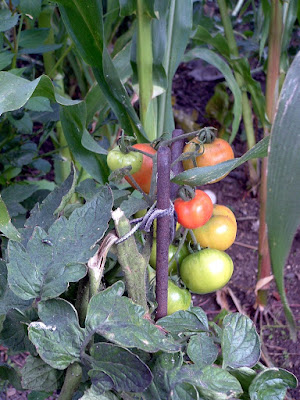 |
| It snapped under the weight of its own fruit, Sep 2022 |
 |
| I think my stakes were too short, Sep 2022 |
I have about four cherry tomato plants growing in planters at the allotment, which have certainly been producing consistently all summer: enough to pick a few bowlsful every week. Also at the allotment, I put down about a dozen or more of the salad variety, but these haven't really performed well. The planters were filled with pure compost, but the plants in the ground have been languishing among too much grass I think. Not a lot of fruits, and those all have been small-ish.
At home I have a total of six of the salad variety plants, well spaced and sans pasture grass. I pinched out the growing tips once they reached the tops of their 1.25 m supports, but this did not stop them as seen in the photo above (although the stem is nearly split in two, it's still ripening the fruit that caused it to snap, so heavy they're almost touching the ground).
Most of these salad tomatoes have been peeled, sliced, and dehydrated for winter use, but some have actually gone into salads. They have also been very nice grilled on the barbecue: olive oil, salt and black pepper; and the same treatment for roasting in the air fryer which hardly takes any time at all.
20 September 2022
Corn? Not yet
 |
| I hope they can ripen! Sep 2022 |
Despite being in the third (nearly) week of September, some of my corn ears are still just emerging. As mentioned previously, it was planted late: the initial batch was destroyed by some sort of animal at the allotment (probably mice/rats) and I sowed the rest of the seed in the packet immediately, with fingers crossed.
 |
| Dahlias in front, Glass Gem popcorn behind, Sep 2022 |
Incidently, this is a very tall corn! The biggest plant is even taller than our grape arbor, shown in the previous post--I would estimate about 3 m tall. The plants themselves look absolutely beautiful and healthy: good thick stalks and luxuriant leaves. And while a few have just one or two cobs growing, most of the plants have three cobs, a couple with four, and there is even one optimistic grower with five cobs. Wow!
13 September 2022
Brassicas in autumn 2022
 |
| No grapes worth picking on this vine, Aug 2022 |
I believe the ducks helped keep the caterpillars under control (to some extent), and I know the parasitic wasps have been about, as there are many little dried up caterpillar husks. I've even seen the regular big wasps out, and watched one sucking out the juicy bits from a big fat caterpillar. In addition, I think getting the cabbages into good soil--and getting them in fairly early--meant they were big enough to withstand some pressure once the hordes descended. The sprouts had less time: maybe I needed to start them earlier?
I've cleared away about half of the kohl rabi now (the biggest ones), and most of it has gone in the freezer for winter. I can't believe how well they turned out--not really troubled by pests (thank you ducks) and nearly all of them swelled up nice and fat. I'll definitely grow some next year. They are a bit of a pain to peel if eating raw (they make a very nice coleslaw when grated), but to cook I just dump them whole in the slow cooker for several hours, let cool and then peel.
Speaking of swelling up, the swedes (aka rutabagas) made a good start but then had too much duck for too long I think; the ducks ate their leaves and that was it--they did the same to the remaining lettuces. Still, I can't really complain as the ducks have done far more good than harm, and there were only about a dozen or so swedes left after the pigeon had at them in spring.
06 September 2022
Food totals August 2022
30 August 2022
Fruits for winter
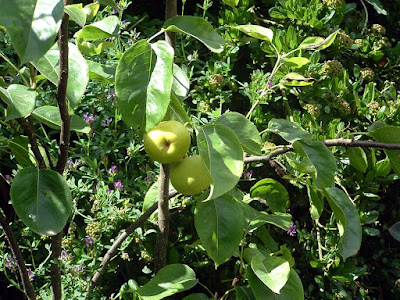 |
| Checking them every day, August 2022 |
Those two Kumoi pears above (and their third and final sibling) will probably go into the fresh category. I've now dehydrated most of the figs and the plums and Sparta apples are almost ready (though the Laxton Fortune apples have nearly all been eaten). I've got a bag of Morello cherries in the freezer from earlier in the summer, and a bag and a half of wild blackberries the son and I picked--it was a great year for them (they're usually small and seedy). I was hoping for some good grapes, but it looks like they haven't thrived in the dry summer we've had; there's a lot of small, partly-formed bunches. If I possible I'll dehydrate them, but they might only be good for the birds.
Now at the end of August, fresh fruit season is nearly over for us. I would normally have yellow raspberries next month, but I transplanted them to the allotment early this spring and they haven't flowered. Hopefully next autumn. In September I hope to pick some wild (or feral, at least) apples to store, and that will be it until next June at the earliest.
23 August 2022
In summer, but looking to winter 2022
 |
| Achocha--it self seeded (from a self seeded plant last year!) August 2022 |
It pays to start planning two seasons ahead when growing your own food. To some exent, I do this (but I'm still not great at it). Right now, late summer, I've started some more lettuce seed, along with spring cabbage and cauliflower seed. I hope to get a few more things going for autumn/winter growing, like chard and mizuna.
But my main planning was done back in spring, when I sowed and planted the main crops, some of which I have been busy preserving for winter; I froze a few little bits earlier this summer but am on to the main harvest now. Nearly all the beets and kohl rabi have been cooked and frozen, and I'm starting to dehydrate the first of the regular tomatoes (we're eating the cherry toms fresh); I'm also dehydrating figs. I hope to preserve apples and plums soon, and if I'm lucky I'll get some corn (it went out late and is a long-season variety to boot).
I also sowed and planted the main winter crops already: the cabbage, kale and Brussels sprouts. These all have some degree of growth, though all have been set back by those pesky caterpillars. Next year I'll have to plan ahead (again) and try to rig up some butterfly netting. I should buy some later this year--I've got a few small lengths, but I'll see if I can get a big piece.
16 August 2022
Mid August 2022
 |
| Uh oh! Aug 2022 |
I don't have quite so many planters this year, as most of the large ones have gone to the allotment to hold strawberries and cherry tomatoes there. The idea was to keep them out of the beds and thus out of the encroaching grass, but now all the pots have that same grass (at least it's easier to weed out)! I try to visit daily to water them, and have been rewarded by both; though the strawberries finished by July, the tomatoes are now in full swing.
Along with hand watering, my other main job (well, besides harvesting/cooking/preserving) is collecting caterpillars off my brassicas. The purple sprouting broccoli in particular looks very bad (pictured above). Every few days I'll take a bucket with a little water and start filling it up for my ducks: brushing, picking, or shaking off caterpillars into the water.
The ducks go crazy for these caterpillars; they've had a few free range spells to go out and self-harvest, but they poo so much I really don't want them out there all the time--we want to go out there and enjoy the lawn and patio. And they started self-harvesting my lettuces too--so they get a hundred or so caterpillars in a bucket instead (which take about 10 seconds for the three of them to slurp down). I guess since the lettuces are nearly finished now I might let them have another day or two, and save me a job.
09 August 2022
So big!
I've been harvesting the largest kohl rabi and gradually clearing out that bed; in their place I may put down some of the Brussels sprouts which have been growing on in a small holding bed, a la John Seymour. I was going to plant them at the allotment, but have decided against it. The purple sprouting broccoli may still go up there (also growing on), but I've yet to decide.
 |
| Maybe I planted a little too close? Aug 2022 |
 |
| The tallest corn is as tall as me (I'm 165cm) and the toms are not far off, Aug 2022 |
Why so big? I attriubute it to soil building, mainly. Chickens and ducks have been a big help in that, and I also think being no-dig is a factor, as clearly the soil life is happy underneath. The weather has been favorable too with a good proportion of sun and rain; I think it's just all come together this year for a Big party.
02 August 2022
Food totals July 2022
26 July 2022
Surviving a heat wave
 |
| Too hot to enjoy, July 2022 |
We also took the decision to bring the chickens back home for the duration, as there is no real shade for them at the allotment, other than a little lean-to in their yard. At home their yard is under our mature horse chestnut tree, and though they were certainly too hot for comfort, they weren't hot enough to be in danger for their lives. The ducks have plenty of shade in their large yard and got some fresh water in their muddy pond daily, so they fared better than the hens.
Incidently, transporting the chickens broke our little hen Cookie out of being broody, thankfully. She was hunkered down in that cramped nest box for a couple weeks and not giving up, despite us taking her eggs every day.
And after reaching 39.5C by my own thermometer, we thankfully fell back down to the low to mid 20s which is what we are used to for July. And some rain too (also typical for July).
19 July 2022
Drawbacks and setbacks (in the allotment, July 2022)
In my last post, I ennumerated all the reasons I am happy about the kitchen garden. Nearly everything has turned out well, and any failures have been slight and easily overcome.
Let's talk about the allotment now.
In the first place, I have had some successes so far this year: the raspberries have been crazy productive, the peas and broad beans are acceptable, and the garlic was great. We've had some good beets, artichokes and strawberries. Some good things going on, yes.
But I like to keep it real, so here's some of the things which haven't been a success:
Disappearing plants. All the corn, cucumbers, squashes and zucchinis, about half of the peas and broad beans, and various other transplants just never made it. I posted about trying soil blocks this year, in the hopes they would transplant better: nope. No discernible difference at all. Pretty much everything in a soil block that went to the allotment simply vanished.
Grass and weeds (but mainly grass). I have dug it out--multiple times. I have sheet mulched it--even more times. I have put the chicken tractor on it. It keeps growing back and is constantly on the edge of taking over. The only place it is not growing is on the paths covered in carpet (and not all paths are thus covered), and in the chicken yard. And the chicken yard is only de-grassed because the chickens are currently in it--it regrew when they were locked up at home over winter.
Slugs and bugs. It's bad. It's really bad. This is probably the main reason for disappearing plants/food--there are so many slugs. And part of the reason for the slugs and bugs is the grass--it hides and shelters them from predators (and from me). If I could clear the grass and weeds, it would reduce the slugs and bugs by a huge amount, which would reduce the amount of disappearing plants.
In conclusion, allotment: not that great. Need a better strategy, particularly for the grass.
12 July 2022
Brassicas in the kitchen garden
 |
| A lot going on here, July 2022 |
I took a photo of these kohl rabi a month ago, and two months ago when they were planted out. We've started to eat them! The biggest ones are bigger than a tennis ball, and even the smallest ones are bulbing up (slowly). They are purple on the outside and white on the inside and taste like a swede or mild turnip. Where I've pulled up ones to harvest I've transplanted the last winter Savoy cabbage seedlings I've been growing on in a tray.
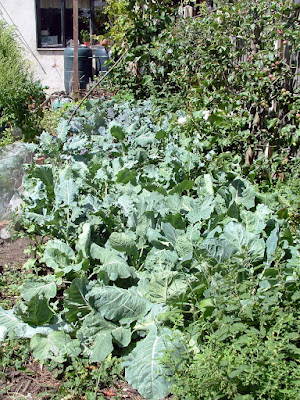 |
| Cabbages: hope they heart up, July 2022 |
The cabbages in the bed next to them are all huge and show some small differences in growth pattern (a few are tall and upright, a few are short and wide, most are somewhere between); a fellow allotmenter gave me the seeds he'd saved so I hope they are only crossed with cabbages, not other types of brassica. I want them to form big fat heads! We'll eat them regardless, but probably not till autumn at least.
 |
| Protection, July 2022 |
As mentioned in a previous post, I lost most of my swede seedlings to a pesky pigeon, so I replanted the rows with corn (which was also a replacement crop, the first being lost too); these were initially covered in insect mesh, but when the corn grew tall enough I took it off and put a different cover over it: a table with a wire cover and bird netting draped around two sides. The other two sides have strategic sticks blocking a flight path in, and all of it combined seems to have detered the pigeon, as the remaining swedes have flourished underneath: pictured right at the center of the row. The corn looks good too, as does the lettuce (hard to see in the photo) I interplanted it with.
Lastly (not shown), I planted out the Brussels sprouts and purple sprouting broccoli somewhat close together in the rows where the fennel and carrot seeds underperformed; they are both growing on for the present, to be transplanted out at the allotment late in the summer. One is covered with bird netting, the other with the insect mesh--to keep the pigeon off them while they grow bigger. I need them to be big and strong to withstand the slugs at the allotment!
Everything looks pretty good in the kitchen garden; I'm really pleased with how it's turned out this year. I'll have to discuss my somewhat underwhelming allotment in the next post.
05 July 2022
Food totals June 2022
 |
| Almonds and grapes together. July 2022 |
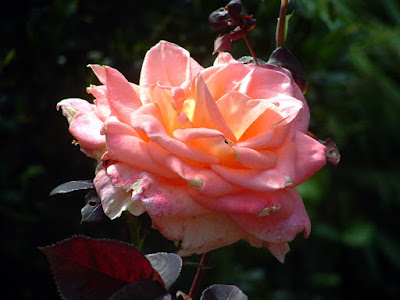 |
| Most of the roses came with the house but I chose this one myself. July 2022 |
28 June 2022
How I use my herbs
 |
| The herb garden, June 2022 |
Chives: I like it in the occasional omelet, makes a nice addition to salads and/or salad dressing, or I'll pick a large handful and chop into thirds and treat it as a vegetable in a stir fry.
Rosemary and marjoram: mainly used in a bouquet garni with thyme when making tomato sauces.
Mint: I try to collect a large amount to make mint vinegar, an excellent condiment for lamb and a nice addition to salad dressings. Any leaves left are dried for tea (good for an upset stomach or for calming before bed).
Chamomile: leaves and flowers dried for tea.
Lavender and rose: flowers/petals dried for winter fragrance. I have been experimenting with soap-making, and these may be incorporated into a batch one day too.
Dill: large stems and fronds are steeped into vinegar for use in autumn vegetable pickling, seeds are collected and dried for the same (and some saved for next year's sowing).
Coriander/cilantro: my first year successfully growing it (slugs normally demolish it); we have been enjoying leaves in salads and as a garnish; I hope to save seed for sowing and cooking.
Nasturtium: occasional flowers as a salad garnish (spicy!), leaves used fresh in stews and sometimes dried for winter use.
Basil: (another one the slugs love) I use it fresh on pizza, in salads and salad dressing, in omelets, and I try to freeze batches of pesto for winter use.
21 June 2022
Cherries 2022
 |
| Lots of little Morello cherries in there, June 2022 |
I've just started picking this year's harvest of Morello cherries, pictured above. I scrounged the net from an abandoned allotment two years ago and it's done wonders for keeping the birds off. I have some other bird netting which prevents birds entering, but the gaps in the weave are large enough for them to peck through quite easily--I needed to erect a little structure around the tree to make sure the netting wasn't too close to the fruit. But with this netting, I can just wrap it around quickly and easily and not worry about losing any cherries.
I planted the Morello cherry tree when the son was just a baby so it's about as old as he is: 12.
I have two younger trees, both sweet cherries: a Kordia and a Stella. The Kordia has been around longer than the Stella and is fairly tall (the Morello is a mini-dwarf). We've never had many fruits off Kordia: it's too big to net so the birds get most of them. Although it was covered in blossom this spring, it's shed a lot of immature cherries so we still probably won't get very many.
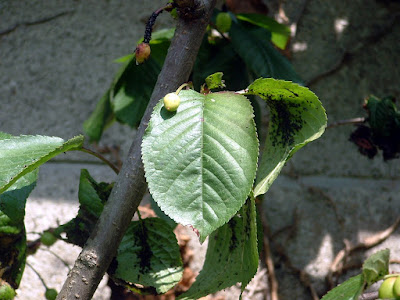 |
| Stella cherry, not doing so well, June 2022 |
The Stella has been in place only a few years and again, no real cherry harvest off it yet. It's badly affected by blackfly this year--the sparrows helped Kordia recover from them a few years ago, but it looks like they're not stepping up yet for poor Stella. It formed some cherries but most have dropped off before ripening. I'll leave it alone for now in the hopes the local birds will do something about it. It was only a £5 tree (from the supermarket)--not a huge loss though I hope it will survive.
Morellos are acid cherries, best used in cooking. I found a bag of last year's in the bottom of the freezer the other day! I've started freezing the new batch too and once they are all collected I might make a giant cherry pie.
14 June 2022
Growing on in the kitchen garden
Compare these photos from last month's post.
 |
| The transplants are growing but the seeded rows aren't quite, June 2022 |
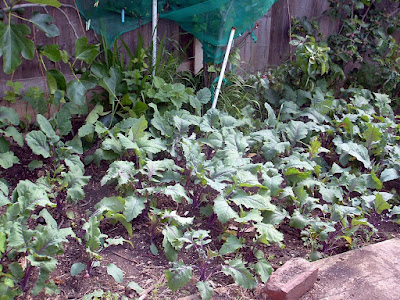 |
| Kohl rabi growing furiously, June 2022 |
In other gaps in various rows I've transplanted some lettuce seedlings, including where it looks like some of the herb varieties I put down were just too old to germinate; only dill and coriander have come up. The carrots are also pretty sparse even though it was new seed, but surprisingly I have a few parsnips coming up (I've never managed to grow them before). There are only a couple fennel too, unfortunately.
I may use the fennel row as a holding bed for my winter brassicas, to allow them to grow on a bit more before transplanting to their final places at the allotment; I need them to be as big as possible to survive the slugs and bugs there and they don't mind being transplanted--right now they're still in a tray.
The tomatoes are all putting out their first trusses of flowers and have all had sideshoots pinched and have grown enough to need a second tie to their support poles. The green kuri and yellow crookneck squashes however are still somewhat small, though have grown a little since transplant (unlike their counterparts at the allotment which seem to have mostly disappeared).
The husband put down some marigolds and geraniums (bought on the cheap), and cranesbill (transplanted from the front garden) around the perimeter of the beds; I put down some California poppies and a few dahlias too. I've been hoeing and hand weeding the multitude of poppies that self seed prolifically, along with most of the nasturtiums though a few of these have been allowed at the very edge of one bed, to climb up a small support I wove out of laurel trimmings.
07 June 2022
Food totals May 2022
31 May 2022
Gardening on the cheap: reusing waste materials
 |
| Eggshells, general compost, soaking vegetables, May 2022 |
 |
| Black and blue trays from my old workplace, originally holding mushrooms, May 2022 |
At the allotment I have a stack of pallets in various states of repair , intended for making a structure--probably a large compost bin to replace the smaller black plastic ones (also free). Some of them already contributed to our little tool shed and chicken coop there. And the chicken tractor (not currently in use). Pretty much everything we have at the allotment I got for free--not completely but almost.
Actually I'm trying to think of garden materials I own that I did actually buy. Some of the tools I guess, and some chicken wire. I'm not above taking things people leave on the street, including large boxes left out on recycling day. Like I said, if I can get it for free I will!
24 May 2022
Planting out the allotment
If only I could get the chicken tractor at the allotment! They tractored it a bit the first year we had it, but it was not a secure situation (we had several escapes) and there weren't enough chickens to really make a dent in the weeds/grass. They've done wonders on their yard; I've now fully dug it out (even excavating it a bit lower) and spread it around. We need to be able to move their yard every year: a very slow tractor. The husband says maybe he'll do it this winter. The chickens are now back there, clearing away the weeds that have started to grow in their yard.
I've been gradually shifting seedlings to the allotment from home where they started: some trays began on my kitchen window, others outside on my patio table but regardless, they all began life in the relative sheltered environment of my home before being shipped off to the more rugged existence at the allotment.
The first transplants were the onions and leeks, both of which seem to have survived mainly intact. Thankfully these are not too attractive to pests, unlike most of my other veg. Next up were the first batch of beets, then cherry tomatoes and regular tomatoes in planters and in the ground. The slugs and bugs definitely took an interest in the tomato plants but they seem to be all right.
The corn, squash and cucumbers however have not been as successful. Out of a dozen cucumber plants, only one sad one is left, and I don't have much hope for it. I've also replanted two (of eight) yellow crookneck squashes and have resown the remaining 20 corn seeds at home in a tray, as they've all disappeared--maybe mice? It might be too late for them, but I'll replant at home despite being pretty much out of room. I also planted the last three crooknecks here, in the hopes we'll get some if the rest succumb at the allotment: slugs.
Finally, there are still about half a dozen green kuri squashes to transplant (two went in at home along with all the sparse French and runner beans) and that's it for the summer plants. A little later on, when they've grown bigger, I'll transplant the winter brassicas.
17 May 2022
Planting out the kitchen garden
 |
| Tomatoes and rows marked for seeds, May 2022 |
 |
| Kohl rabi (and some cabbages) with cherry and apple trees, May 2022 |
 |
| View from the path to the lawn, May 2022 |
 |
| View from the chicken yard, May 2022 |
10 May 2022
DIY soil blocks
I've attempted sowing seeds in soil blocks for the first time this year, mainly summer crops such as pumpkins, corn and beans; most of them seem good and strong, but I'll withhold judgment until after transplant. The idea is that there is less root disturbance when planting out and therefore less transplant shock. It would be great if it worked out, as many of my summer plants succumb to slugs and bugs during transplant shock.
 |
| Waiting for beans to sprout, April 2022 |
It was kind of labor intensive to make the blocks by hand though--I had to mix up compost and sand and then press each block through a little mold I made (out of a 300 mL plastic cream pot). If I was growing to make money, I'd buy a special tool to save me the time but I can spare it for just myself.
 |
| Nice day for tomatoes, April 2022 |
03 May 2022
Food totals, April 2022
 |
| Need to eat before it flowers, April 2022 |
26 April 2022
Chicken tractoring and new transplants
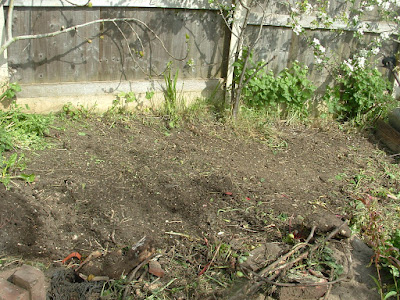 |
| Ready for planting (only a little weedy), April 2022 |
 |
| Made from pallets, wire and bubble wrap, April 2022 |
To that end, I've transplanted out about 50 kohl rabi seedlings into that first bed, with another 30ish waiting for the next bed; I've also got a tray of about 30 cabbages ready to go too. And maybe next month I'll try direct sowing some swede/rutabaga in the hopes they'll come up (not had any success with them before). Because the chickens have tractored the beds for me (and are currently undertaking a second pass) the slug numbers should be reduced, giving me a better chance for direct sowing--unlike at the allotment, sadly.
 |
| Kohl rabi in front, April 2022 |
19 April 2022
Flowers from seed
I haven't grown many annual flowers over the past few years, having concentrated on vegetables for the most part. I do have many perennial flowers, some which were legacy plants from previous owners and some I chose and planted myself. I love flowers and enjoy picking my own bouquets from the garden (always an acceptable host gift too, I find). One of my garden objectives is to grow a beautiful space. Now, without taking on more than I can reasonably handle, I want to add more flowers this year.
To that end I'm going over my seed stash and trying to sow as many flower seeds as I have left, before they get too old. Many are already too old! But I have some coming up and some were sealed in foil packets so I still hold out hope for them. Some of these seeds I have grown in the past, and some were free seed packets which I never tried. I don't care what they are, so long as they flower.
I want this year to be more beautiful. I want lots of flowers. Lots of vegetables too, but lots of flowers with them.
12 April 2022
Pricking out and potting on
I'm in the middle of my seed sowing extravaganza which started slowly last month but has been ramping up steadily since. Quite a lot of the early seeds are now little seedlings: broad beans, peas and snap peas have all popped up at the allotment (a bit patchy but good enough) and tomatoes, some brassicas and onions/leeks (and more) are all in seed trays at home, both indoors and out. I've even transplanted a row of chamomile seedlings up at the allotment.
When I sow seed trays I generally broadcast the seed over the top and unless the packet says not to cover, I'll scatter them over with a thin layer of crushed eggshells; these are air dried first and are fairly easy to break up by hand if necessary, though I generally tip them in a bucket and smash them with whatever hand tool is nearby (rake, mallet, trowel, etc) or even my shoe. Some seed packets give instructions to cover with a layer of vermiculite and I find the eggshells are an acceptable substitute: seedlings are excluded from light and seem to poke through just fine.
I stopped using modules for most seeds; in my own personal experience the seedlings are smaller when sown in them compared to the seed tray. However, it's imperative that seedlings are pricked out of the seed tray before they grow much, or they will be in danger of stunting--and therefore underperforming. This weekend I filled two deeper seed trays and pricked out a few dozen kohl rabi seedlings from their original tray. I picked the ones with the biggest seed leaves, which were growing their first true leaf; these I gently teased out with the help of a wooden skewer and replanted into the deeper tray about 3-4 cm apart. I gently watered them in and will keep them slightly moist until they grow big enough to transplant later this month. The smaller or slightly deformed seedlings I discarded after pricking out the big ones (these aren't usually worth growing, as they will be too small to harvest). I sowed the seed trays outside to save on the hassle of hardening off which I would have to do if I sowed them indoors (they don't need much heat to germinate, unlike some seeds).
I do use individual "modules" for runner beans and other climbing beans (though not for peas) as they don't transplant well: I save toilet paper tubes and make similar sized tubes out of newspaper sheets for these and then just pop the paper tube right into the ground when planting out. I've tried pre-sprouting them as for peas (a handful of seeds into a bag of wet compost till they sprout) but the bean seeds haven't performed well for me like this; maybe because I start the peas much earlier in the year before the pests are very active? Not sure, but I would rather have 30 bean plants transplanted than 100 seeds fail to come up at all. I also start pumpkins, zucchinis, etc in individual pots for the same reason. These seeds, and tomatoes and sweetcorn and the like are all sown indoors.
Now just a few plants will go on to be potted on after pricking out; my tomatoes were pricked out into trays last month, and are growing well enough on my kitchen windowsill to be potted on--it's way too early to transplant them outside but I want them to keep on growing bigger until I can in mid to late May. These I will pot on into their own pots in my rich homemade compost mixed with a bit of sand (or finely crushed eggshells if the sand runs out). I may have to pot them on again into bigger pots, depending on how well they grow: here's hoping!
05 April 2022
Food totals January-March 2022
29 March 2022
Birds + indoors = sad
I have been pondering the future of my little flock with the prevalence of avian influenza, aka bird flu. In this country all poultry, both commercial birds and pets, have been required to stay indoors for the past sixteen weeks. (Apparently that's legally the longest "free range" birds can be confined and still be allowed to be marketed as such; this designation ran out yesterday.)
Last winter we had to lock up our birds until around now. We had to lock them up in the winter of 2016-2017 too. This winter has been particularly bad for outbreaks, and there are still outbreaks happening; the housing order still remains, maybe indefinitely.
I have six hens and four ducks. They have a wooden playhouse that has been converted to a coop, and I've rigged up a very small covered porch for them outside their small door (made from a wire fireplace guard) so they can at least step outside for a breath of fresh air. I try to bring them fresh greenery/weeds daily, but they aren't happy. I don't blame them; I'm not happy about it either.
And what with the price of layers pellets going up--almost double what we were paying a year ago--and then they aren't even laying much (the ducks not at all), well it seems like a bad deal for everyone involved. I've kept birds for about ten years now and this is the first time I feel like there's no future in it.
Ok so how to make things better within the parameters I've described? For now I am keeping the birds. We may let the flock die out (of old age/natural causes) without getting replacements. I have suggested letting the chickens die out but replacing the ducks (and a flock size of around 4-6). But whatever we decide, we need to make our current situation better than what it is; it's been like this too long and is not good enough.
I have to keep the birds under cover; that is a given. A fully enclosed chicken tractor is allowed as long as wild birds are completely excluded. I live on a very small property in a rural village but I have done a chicken tractor before: I have a small moveable A-frame coop in the back corner of the Perennials section which is still in fairly good condition; the husband made it out of some pallets, chicken wire and bubble wrap insulation; the chickens used it at the allotment for a winter before we built them a permanent yard there.
This is going to be put back to use right away, starting on the veg beds. It has no floor so they'll be able to scratch and peck the ground and it can be moved daily; they can even sleep in it. It has no nest boxes or perches, somewhat of a drawback; but it is better than being perpetually boxed up indoors. I'll try to sort something out, but they (the chickens at least) are going in it immediately.
22 March 2022
Spring equinox at last
It's felt like a long winter--maybe because I was working too much and getting up too early! But finally it feels like spring with longer days and soon to be shorter nights. The daffodils are in full swing, my almond tree is flowering and new plants are coming up at the allotment.
I haven't done a lot of work at home in the garden to be honest. This past weekend I did some pruning of ornamental shrubs and trimmed down two bundles of pea sticks for (you guessed it) the allotment. I've been harvesting either chard or cabbage greens most days here at home, and some new chive shoots too, and getting seed trays started both indoors and out. But actual garden work? Not a lot.
However I'm still digging out the chicken yard at the allotment most mornings. I think I'm at about 3/4 now, and have been sheet mulching with it on the lower beds--trying to cover up the grass again. I'll probably sow some seeds direct, and maybe transplant some seedlings a little later on. I need to sheet mulch a bit at home too, where the creeping buttercup has taken over one of the beds in the veg patch; I can't be bothered to make the effort of digging it out.
I haven't fully decided what to grow here at home this year. Last year was roots, though the chard sort of took over. Maybe I'll do roots again, after clearing away the chard.
15 March 2022
This week, March 2022
Our household has been busy this past week with two birthdays: the son turned 12 and the daughter 2. Despite all my responsibilities, family first of all, I still managed to get to the allotment nearly every morning for some more digging. I estimate I'm about halfway in emptying all that good compost from the chicken yard; it sits around 4-6 inches higher than the surrounding beds, so that's what I'm trying to take off the top.
Yesterday morning, after baking a cake, the daughter and I made a quick trip up there to drop off our full compost tub; she asked if we could dig some worms, but I said we didn't have time, and we should just go look for them instead. Didn't find any (the husband said they all hid when they heard her coming). It was such a nice sunny morning I was expecting to see other people there, but we hardly ever do. Other allotmenters must come in the afternoon.
I've got some cherry tomatoes sprouted up from that old seed packet, to my surprise. Even though I prefer large tomatoes, cherries are more likely to ripen in this climate; but I'd be happy to get any of any size. I have a great recipe for green tomato salsa, so red or green is good by me. Hopefully no blight this year (scuppered all plans for salsa last year).
I've also got some peas sprouting up at the allotment, though no sign of the broad beans--other than one dug up and partially eaten; I fear that may have been the fate of all the others. But my next batch of peas (snap peas this time) are sprouting and ready for sowing, along with some beetroot seeds. Today or tomorrow I think. Also need to get some more seeds started, of all shapes and sizes. It's spring and I'm feeling the push.
08 March 2022
My morning walk
Since reducing my hours at work, I once more have a chance to walk up to the allotment during the week before setting off. I used to walk up with the son before school (the allotment site is on the way to his old primary school). He would do the chicken chores (feed/water, collect eggs) before walking on, while I stayed on to do the heavier digging and weeding. He now attends high school: nowhere near our allotment.
That leaves the daughter and I to walk up after he's left for school. We've tried going at the same time as he goes, but have decided it's still a little cold for tiny hands and feet so wait until around 9 am instead. We put on our hats, coats and boots and strap into the baby buggy--which is helpful for slinging a bag of garden tools onto--and off we go.
It's only about 10-12 minutes away when pushing a heavy toddler; it's more like 8-10 when unencumbered. However, a short walk in the morning does us both good: fresh air, sun if we're lucky, blood pumping with the exercise. I push the daughter until we are actually within the gates and then let her out to walk/run down the gravel track and up to our plot.
These past two weeks (minus one or two windy/rainy days) I have been gradually digging out the excellent compost from the chicken yard, a couple wheelbarrows at a time (chickens are still locked up in their coop at home). The daughter--almost 2--is happy to have a little wander around, stomp in puddles, or catch worms as I dig them up: "Worm!" "No, worms need to stay there." "Worm!!" "Put it down gently...!" "Worm!!!"
The compost has been spread around the raspberry patch and spring cabbages, both now pretty grassy; I managed to remove some clumps from around the cabbages but it's really entrenched among the rasps. The plan is to smother the grass with loads yummy compost which will soften up the surround soil enough to just pull it out. Wishful thinking?
I only do a little at a time: partly as I don't want to exert myself too much before work, but also because the daughter gets bored/cold/wet fairly quickly. When finished, we put our tools away, walk back up the track and load up into the buggy once more before walking home. It's downhill all the way.
01 March 2022
Getting a little more done
After wet and windy weather for our week off, the weekend was surprisingly calm and bright, and even warm enough to spend leisure time outdoors! We had some friends over and sat out in the garden for an hour with our drinks. I also finally put the clothesline to use, taking advantage of that cloudless sky and slight breeze; I dried several loads of laundry, which always smells and feels so much nicer when dried outside.
However, I didn't actually manage to get to the allotment or even do any gardening over the weekend, except to harvest a bit of chard out back. No matter, the daughter and I braved the rain yesterday before work/childcare started and sowed two large rows of peas which I'd pre-sprouted. We got wet and muddy but at least the peas are down.
I also started an old packet of cherry tomato seeds on my kitchen windowsill; it was unopened (it was free) but several years old so I just chucked all the seeds down on a little tray in the hopes that some will germinate. I don't think I have any other tomato seeds--I thought I had some I'd saved but couldn't find any. It's not a big deal though; I can probably get some free plants off a friend or fellow allotmenter, but I won't be disappointed if I don't. It's not a good climate for tomatoes and I always grow them with fingers crossed; the last few years I didn't get any tomato harvest worth speaking of.
Next up, it'll be time to pre-sprout some beets. Sowing them direct has never been successful for me, so last summer I tried sowing them in trays and transplanting out; I got some good beets this way but I would prefer to make less work for myself so will try sprouting some this time. If it doesn't work, I'll do trays again--I like beets a lot and am willing to put in the effort if I have to.
Now that it's March, I'm starting to think of all the jobs I need to get done. Spring is just about here, and stuff needs to get going if vegetables are to be harvested this year.
22 February 2022
In the allotment, Feb 2022
This week the son, daughter and I have time off and already I've been to the allotment twice. Just for quick visits: it's been windy and rainy for a few weeks now, and not pleasant for working (especially with a toddler); regardless, stuff has been done.
Yesterday we quickly dropped off kitchen scraps for the compost and transplanted a rooted year-old redcurrant cutting. We have a sort of Perennials section at our allotment: a long strip at one edge that comprises the raspberry patch, a couple of rhubarbs and the newly moved gooseberry. It now also contains my yellow (autumn-fruiting) raspberry bush too, transplanted today. (Maybe I should move the artichokes there too.)
Today I sowed around 60 pre-sprouted broad beans in two rows and the son picked a good portion of Brussels sprouts for our dinner. We've picked pretty much all of the big ones now, so are working through the smaller ones; I think there are only one or two meals left to harvest.
I have a good sized sack of peas soaking too, some of which have begun to sprout so they will be sown hopefully before the week is over; if not, I'll have time to go up with the daughter before work/childcare as my reduced hours start next week. And I plan to empty and relocate the large planters from my patio; I'll refill them with fresh compost and probably put in some more strawberry plants. Along with this, I'll transplant a rooted fig cutting I took last year.
There's plenty to do, and if I want to have a productive harvest I'd better get things done.
15 February 2022
Little and often (I hope)
This past weekend, before it started raining (again) I managed to get outside and harvest a few overwintered carrots, cabbage greens and chard. I also sowed two seed trays for the kitchen windowsill and even took four cuttings from my yellow raspberry. I spent 10 min max out back, and did not visit the allotment; I haven't been there for several weeks now, though the husband has dropped off kitchen scraps for the compost a couple times. He also took up some old carpet from a neighbor, for long term weed-smothering. I'm hoping to score some more pieces to cover the front quarter; if I can find some I'll probably leave them in place for a full year. We already managed to cover most of our path with some hallway carpets from another neighbor, to be in place long term.
I may have a little more time for gardening in the very near future, after agreeing with my work to reduce my hours by about a third. Next week is half term (no school for the son and me) and after that my new hours will begin. I hope to take the daughter up to the allotment for a daily walk before work/childcare starting then, instead of our early mad rush to get to our respective places on time. I can't see us being extremely productive (she's not quite 2) but little and often is a good mantra for gardening!


